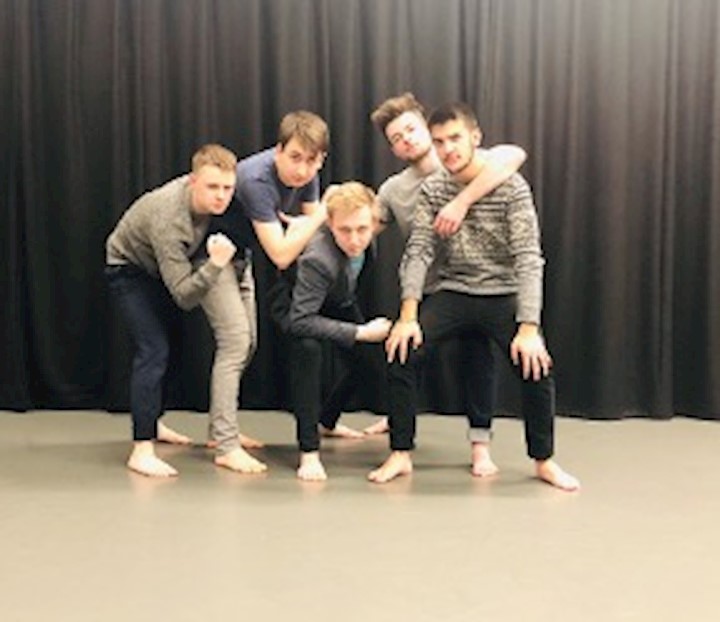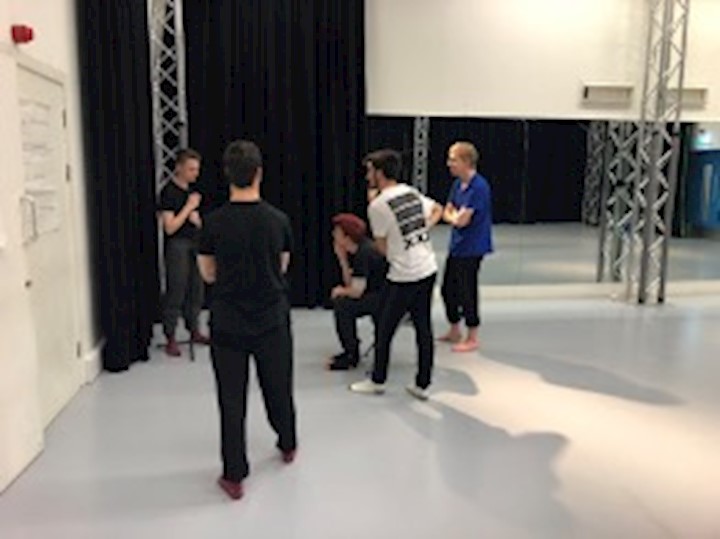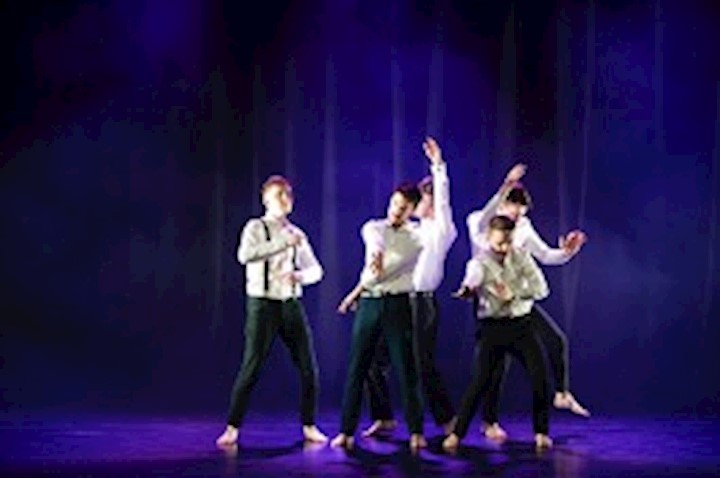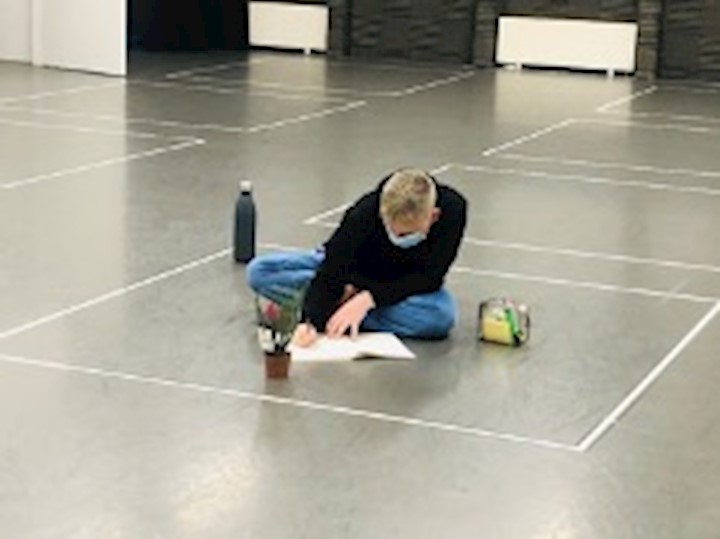Abstract
In this writing I offer reflections on founding and choreographing an all-male dance company as an extra-curricular endeavour with the dance company Higher Education. The aim of the company is to address feelings of 'otherness' and loneliness in male dancers at University, and to provide an opportunity for fun and creativity in order to create strong peer relationships. I discuss my thoughts, processes and observations made as I have worked over three years with the company. The work assumes that providing a space to be creative means that dancers are able to develop relationships with each other, and to build a community of peers. The company is driven by a need for 'togetherness', and we continue to find ways to create this as we shift between face-to-face and online meetings.
The boys project came out of a need for a space for togetherness. In 2018 there was approximately 1 male to every 20 females on the dance course at the University, and the feedback we always received was the overwhelming sense of ‘otherness’ or a sense of not belonging. This number has increased over the past 3 years, what follows are my reflections on working with the company to build a community of peers, using movement as a way to connect and share their skills.
In 2018 the boys company was created – to provide a place where the students could get together and create a type of comradery. The company invites anyone with an interest in dance or movement to be part of the company for a minimum of one academic year. Each week, the company meets in the early evening and works towards a small-scale performance for an end of year sharing. It was important to offer a performance opportunity – as a motivation to participate, but also as a motivation to remain involved; a shared goal.

The sessions are as much social as they are creative, and the participants are invited to draw on their skills as dancers and performers to create an original work under my guidance. As a choreographer, I wanted to provide a space which was as meaningful as it is fun, and as productive as it is sensitive. Sessions start with an informal conversation, and this often transcends to fits of laughter. On reflection, this laughter helps to create a sense of equality – both among the participants, but also between myself and the participants. Although this doesn’t eradicate the hierarchical play between choreographer and dancer, it does help to communicate an equal appreciation.
When the project started, I would lead the warm up, which had several objectives. The need to physically prepare the body for activity was often outweighed by the need to mentally and socially prepare the dancers for collaborative creativity. Each year, the first few weeks have a tangible sense of nervousness and trepidation – not only for the activity itself, but also for the social interplay of turning up to a new activity, reminiscent of the first day of school or a new job.

As a choreographer, I had an intrinsic awareness that laughter, humour, and play – each different of course, had a vital role to play in creating a sense of ease. Having achieved this in a small way during opening welcome, I would try to create a warm-up activity which allowed for these expressions of joy and enjoyment respectively. As the project progressed, the warm-up was often delegated to one of the participants. This had several objectives, and was often based on a quick reading of the room. It is logical that someone given responsibility among peers will have a different connection in that moment, both with the material and with their peers.
I try where possible to not let my roles of tutor and choreographer overlap during these sessions. I encourage the participants to relate to me as someone they are creating with, as opposed to a member of the academic staff. For me, this allows a much more natural and honest connection – where there is no consequence for what they might perceive as ‘negative’ behaviour, encouraging a sense of ownership amongst the ‘team’. I try to do this also because some dancers I see and teach on a regular basis, and some I only see in the rehearsal space. One of the challenges I face as a choreographer in this area, is not to ‘treat everyone equally’, but to understand and acknowledge my previous interactions with each participants, and in doing so I can consciously work towards accepting and celebrating the talents and personalities of each person – a privilege that isn’t always accessible in curricular teaching.
Of course, it is not possible to simply erase past interactions and knowledge, but it is possible to use these as a way to encourage interactions between the participants themselves. An example of this occurs when I have delegated the warm-up to a dancer, whom I am aware has an interest in teaching and dance facilitation. In this way, I am able to offer the participant some lived and meaningful experience, and also lean into ideas of ‘work-based learning’. However, equal to this, or perhaps more importantly within the remit of this research, is the opportunity this gives for the participants to relate to each other. Participant lead warm-ups, whilst being physically challenging, have also provided a unique opportunity for the ‘leader’ to demonstrate their passion, and their personality, and in this way offers an opportunity for the other participants to relate to them artistically and socially. It is not uncommon for the warm-ups to end with raucous laughter – again, necessary not only for the research but also for the work being created.

The sessions themselves consist of a number of choreographic or creative tasks. However, the project actually begins before this. Each year an initial discussion with the participants takes place, often around a given topic. I try where possible to stay away from topics which relate specifically being male, as I’m aware of my position as a female choreographer. However, over the past few years, I have become increasingly aware that by working with an all male group, any topic for discussion is framed by a male perspective, and I have tried to embrace this as much as possible as I see this as a way I can respond to the needs of the group. An example of this is the first work created ‘Whatever the sun may sing’. This work was based on love languages, and how we give and receive love in various contexts. Whilst this wasn’t an explicitly gender focussed or specific topic, once it was given to the participants it took a natural journey into an exploration of how males give and receive love, and what it is for men to be vulnerable in order to do this.
The creation process in this instance allowed the participants to explore this aspect of themselves, in a way that discussions alone couldn’t achieve. The resulting work explored light hearted humour, all the way through to a darker, more sincere emotive work and movement. As a choreographer, this is the work I am interested in – it explores both the light and dark of topics generally seen to be ‘serious’. The second work produced ‘The Space Between’ took a similar journey, but explored the desire for affection – inevitably, this again transitioned into a work which commented on the male desire for affection. For this work, we stayed within the remit of platonic affection, and within the debriefing interview, the participants commented on the impact it had on them as young dancers and what they thought it communicated to an audience about being a young man.

Whilst the topics and choreographic journeys of this work aren’t necessarily important to my research, they do allow an insight into how other aspects of a creative journey can be impactful on the lives of willing participants. Of course, with this comes a question of ethics – not necessarily on choosing a topic, but in guiding the participants own exploration of the topic. Thinking forward to a further pilot phase, this is certainly a consideration.

When I ask the company members about their experience of the group, the most common words include ‘fun’, ‘friends’ and discussions on how the company has helped to grow their confidence. Over the past year, the company has shifted between online and in person, affecting both the works produced and the feeling of togetherness that initially inspired the company. As we move towards the final semester of the final year for the original company members, I continue to look for ways to build the community we worked so hard to create.